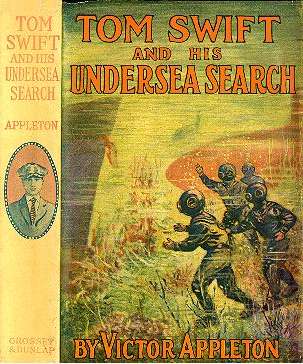 Note:
some of the language, references & attitudes, while acceptable at the time they
were written, are not Politically Correct, today.
Note:
some of the language, references & attitudes, while acceptable at the time they
were written, are not Politically Correct, today.Tom Swift and His Undersea Search
or, The Treasure on the Floor of the Atlantic
By Victor Appleton ©1920 Book #23
Review by JP Karenko, September 2005
Duotone image from the collection of Mark Snyder
 Note:
some of the language, references & attitudes, while acceptable at the time they
were written, are not Politically Correct, today.
Note:
some of the language, references & attitudes, while acceptable at the time they
were written, are not Politically Correct, today.
Summary:
No official summary was ever provided with any of the old Tom Swift books. However, without giving too much away, the plot can be summed up as follows:
Times have changed. The Great War is over, and money is getting hard to come by. Mr. Damon shows up with a new friend, who promises wealth from the bottom of the sea. Tom reluctantly agrees to join the search for the sunken steamship SS Pandora and a million dollars in gold coin.
Like the Greek legend, the strong box on the Pandora contains much more (and less) than the treasure seekers expected.
The usual Hollywood undersea hazards abound, including encounters with various dangerous denizens of the deep and demographic details. The captain of the sub keeps running into things-mostly, the bottom. (He must have been taking piloting lessons from Mr. Damon...)
How the story ends, you will have to read to find out.
This book is available on line at: Tom Swift and His Undersea Search
![]()
Cast of Characters (More or less in order of appearance)
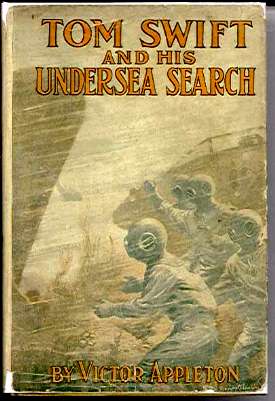 Tom
Swift-Intrepid
inventor & mechanic. Plucky, lively, resourceful, brave and clever.
Home-schooled at a college level by his father, Barton Swift. Athlete and
hunter. Familiar with how to stalk game and firearms. Loves all things
mechanical. Is a decent cook, too.
Tom
Swift-Intrepid
inventor & mechanic. Plucky, lively, resourceful, brave and clever.
Home-schooled at a college level by his father, Barton Swift. Athlete and
hunter. Familiar with how to stalk game and firearms. Loves all things
mechanical. Is a decent cook, too.
Ned Newton-Chum & companion of Tom, No longer employed as a cashier at Shopton National Bank. He has once again resumed his position as Swifts' Financial Manger.
Koku-Giant manservant of Tom. Devoted, loyal, and possessed of great strength, but apparently somewhat limited cognitive facilities. Described as "simple and child like," he is antagonist and rival of Eradicate. Previously said to be terrified of water and anything living in it, Koku dons diving gear and battles a giant starfish attacking Ned Newton with aplomb (and an axe...)
Mr. Wakefield Damon-Elderly & eccentric adventurer whose main purpose in life seems to be blessing everybody and everything near his person. Apparently quite wealthy.
Dixwell Hardley-No physical description. Full of himself, pompous and cowardly. Suspected scammer and con-artist.
Eradicate Andrew Jackson Abraham Lincoln Sampson, A.K.A. Rad-Aged stereotypical Negro journeyman jack-of-all-trades. "Eradicates dirt." Now is suffering the ravages of old age, including difficulty moving and "having de misery in his back." Described as "tottering, Eradicate has now "become too old to do much," but remains faithful to Tom and helps out where he can. His mule Boomerang has passed on and gone to that big pasture in the sky.
Miss Mary Nestor ñ Betrothed love interest of Our Hero. Described as a "fair young woman with flashing brown eyes." Blushes easily, especially around Tom.
Mr. and Mrs. (Amos) Nestor, the parents of Mary. Passing mention. In spite of having sometimes major roles in these stories, Mary's parents are never described and her mother's name has never been mentioned in over 20 books to date. Mary's Dad, (Amos) had his name mentioned in only 3 volumes, and no description, to date.
Barton Keith-Maternal Uncle of Mary Nestor. Wildcatter and speculator in western oil resources. Swindled by Dixwell Hardley out of rightful interest in a rich oil field in Texas. Ill and despondent.
Unnamed Nurse at Keith Residence-No name or description. Caring for Mr. Keith while he is ill.
Crew of the Submarine MN-1 (formerly the Advance.) All are Swift employees.
Captain Nelson-Commander of the boat. Runs into stuff a lot.
Barnes-NFN or description. Generic crewman.
Nash-NFN or description. Generic crewman.
Norton-NFN or description. Generic crewman.
Earle--NFN or description. Chief of the engine room.
Wyeth-NFN or description. Machinist.
Little Englishman-No name or description. Could be the same guy who was tank crew in volume #21, Tom Swift and His War Tank.
![]()
Major Inventions:
The submarine is the invention of choice in this tale. The old Advance (See Vol. #4) is dusted off, refit and "improved." The hull is strengthened, the interior rearranged, side fin keels and "double acting" rudders are installed. An underwater version of the Giant Searchlight is mounted and improved navigational gear is used when "shooting the sun." The newly refurbished craft is renamed the MN-1, after a certain young lady with the same initials.
The "peculiar plates" that made the original sub unique no longer are used, as the power-plant seems to be conventional twin-screw diesel-electric like every other sub afloat at the time.
Much ado is made of an open-bottom diving bell that is now fitted, but it never plays much part in the story. Nelson, diving bell, submarine (Seaview)...Connection?
![]()
Commentary on Society, Attitudes, Environment & Errata
It's amazing how much technology and society have changed. Reading the old Tom Swift Sr. series has given me an appreciation of modern gadgets that I've come to take for granted. Society's attitudes have changed, greatly, too. I wonder what people will be taking for granted 100 years from now, and what they will think of our "modern" society and its' mores (or lack of them...)
Attitudes and Prejudices- Language usage was interesting: It seems less "folksy" and more modern, but without the extensive slang used in the previous volumes. Tom is said to be "cool as a cucumber" under stress, but Ned then wonders why cucumbers are considered cool? ...Good question. Ned "ejaculates" once, making me think this author is the same one who wrote Land of Wonders.
Ned is also back in the saddle as CFO at Swift Construction, which has grown explosively since the end of the war. He actually seems to have some business related duties that occupy at least part of his time, too. We now hear that Shopton is named for the "many shops at the Swift works." Hm! Seems I remember Shopton was there long before Tom started tinkering with a simple motor-cycle in his garage, a few years back...
Ned has now been determined to have a "horror of large fish," and of course, has a run-in with several while EVA, undersea. Koku, on the other hand, who previously was described as "terrified of a simple crayfish," is quite at home in hard hat diving gear, at 500 foot depth. He does a Norman Bates routine (with an axe, no less) on various giant undersea critters that attempt to molest his friends. Go figure.
On p189 Mr. Damon is said to "not approve of any form of gambling." Interestingly enough, he is always ready to speculate in various stocks and get-rich quick schemes, and has to have Tom pull his chestnuts out of the fire, repeatedly. I guess playing the market isn't considered gambling?-Wait 'til 1929 rolls around, guys...
Barton Swift has now "all but retired from the company" due to his age and health, and "has made his last extended journey" with Tom & crew. Passing mention in this tale.
Errata- After four books in a row in Waterford, NY and two more in Waterfield, in this tome, Mr. Damon's home town is not mentioned, making the current tally of his many moves stand at 11-Waterfield, 5-not recorded or confused, and 10-Waterford, for 23 volumes, to date. The numbers don't total, because two volumes have him residing in both places at the same time and five others either do not specify a town name, or have multiple references that change.
There were actually a few typos found in this volume, the first ones in some time: On p43, a messesnger (messenger) shows up, on p82 it seem(s) hopeless, and on p125 a lone (long) pole is used.
The format of my edition of this book is different from my other brown quad G&D editions. The typeface is smaller and the covers seem less substantial. This may be reprint done during the depression years when things were rough and quality materials were not affordable.
Some factual stuff is also confused. The wreck of Boldero (See Vol. #4) is said to be off the coast of Cuba. In the book, it was in deep water (15,000ft) off Bolivia. The illustration on the frontispiece shows the divers in their self-contained suits sans air tanks or the steel stiffeners that make the suits semi-rigid. Tom uses his "doubly charged" Electric Rifle to dispatch a marauding <sic> starfish wrapped around Ned Newton without the least harm coming to Ned. The electric charge is now a straight-line ray, a la Buck Rogers, instead of the previous plasma bullet. I'm not sure I'd want to be on either end of that underwater discharge...When the air goes bad, the crew seeks relief by laying on the floor of the sub "where the air is fresher." Considering they were trying to escape carbon dioxide, which is heavier than air and sinks, this bit of effort would have exacerbated their situation.
Engineering and Science, Fact vs. Fantasy- The MN-1 spends a lot of time blundering around the sea bottom, running into things. Of all the improvements Tom could have installed, better steering, charts and navigational gear should have been at the top of the list. They run aground several times, and get the props tangled in seaweed large enough to stall the drive motors and require EVA to clear them.
Sonar Stuff from http://inventors.about.com/library/inventors/blsonar.htm
Lewis Nixon invented the very first Sonar type listening device in 1906, as a way of detecting icebergs. Interest in Sonar was increased during World War I when there was a need to be able to detect submarines. In 1915, Paul LangÈvin invented the first sonar type device for detecting submarines "echo location to detect submarines" using the piezoelectric properties of the quartz. While he was too late to help very much with the war effort, however, LangÈvin's work heavily influenced future sonar designs.
The first Sonar devices were passive listening devices - no signals were sent out. By 1918, both Britain and the U.S had built active systems, in active Sonar signals are both sent out and then received back. Acoustic communication systems are Sonar devices where there is both a sound wave projector and receiver on both sides of the signal path. The invention of the acoustic transducer and efficient acoustic projectors made more advanced forms of Sonar possible.
The MN-1 could easily have had echolocation gear. The inter-suit "telephones" used during EVA may have been "current technology" rather than Swift-invented devices.
Seaweed Stuff from http://www.glf.dfo-mpo.gc.ca/sci-sci/bysea-enmer/nearshore-littoral-e.html#reds_browns_greens
Light is a limiting factor in primary production (plant growth). In the near shore, light penetration is affected by the presence or absence of sediment in suspension and by the depth of water. In low energy coastal environments where sand and mud build up on the bottom or along the shore, waves, tides, and currents will throw these sediments into suspension. Run-off also contributes to the amount of sediment in the water. Clearer conditions exist off Newfoundland and the Atlantic Shore of Nova Scotia. Depth also limits the amount and type of light in the water. In the uppermost 15 to 20 meters, in clear water, longer wavelengths (reds) of light are absorbed; yellow light disappears by 100 m and green light by 250 m. This means that only certain seaweed will grow at specific depths. Large varieties would be possible, but very unlikely at the 750 ft depth stated.
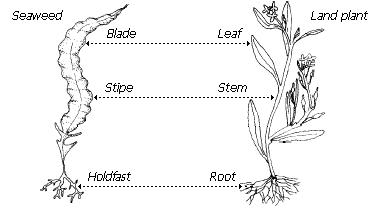
Coral Reef Biology from http://www.coris.noaa.gov/about/what_are/what_are.html and http://www.coris.noaa.gov/about/biology/biology.html
Because of their dependence on light, corals require clear relatively shallow water. Thus, coral reefs generally are found only where the surrounding water contains small amounts of suspended material, i.e., in water of low turbidity and low productivity. Corals prefer waters that are nutrient-poor. Paradoxically, they are among the most productive of marine environments (Barnes, 1987).
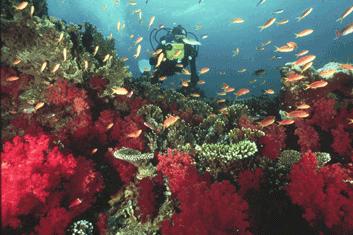
Corals' requirement for high light also explains why most reef-building species are restricted to the euphotic (light penetration) zone, approximately 60-70 m ( less than 200ft depth ) according to Lalli and Parsons, 1995.
Starfish Stuff from http://www.tourismvictoria.com/Content/EN/477.asp
Starfish, or sea stars, are members of the same family as sea urchins. They are usually radically symmetrical ,with five sections, or arms. At the end of the arms of some stars are small, light-sensitive pigment spots. The bottom of their arms are covered with many suction cup-like tube feet that they use to move. Starfish grip their prey with tube feet and pull open shells. Starfish insert their stomachs into their prey, where they digest the food. Sea stars have the amazing ability to shed arms to escape from predators and then regenerate them later. They have small claws that cover their surface and prevent the settlement of other organisms.
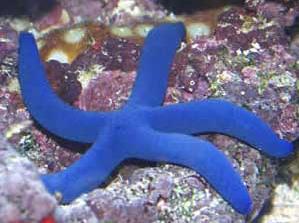
Blue Linkia can grow to 12" diameter. (That's inches, not feet. )
Ned's encounter was somebody's pipe dream. Then of course, things do look bigger under water...as far as being ambushed, an energetic inchworm could give a starfish a run for his money, speed-wise. A big squid would have made a better monster, but that critter was already taken in another book.
More Starfish Info at http://www.marlin.ac.uk/species/adult_gen_Asteriasrubens.htm
All of the various dangers faced in the book, could possibly have happened, (except the starfish) just not at the 700 foot depths stated to make the story more "fantastic."
Geography
And all I ask is a tall ship, and a star to steer her by... The ocean as described is more or less realistic except the depths at which all this adventure occurs and the size of the critters encountered. Below is the arena where the plot is laid out. It's "about 1 day's sailing from St. Thomas," but in an undisclosed direction.
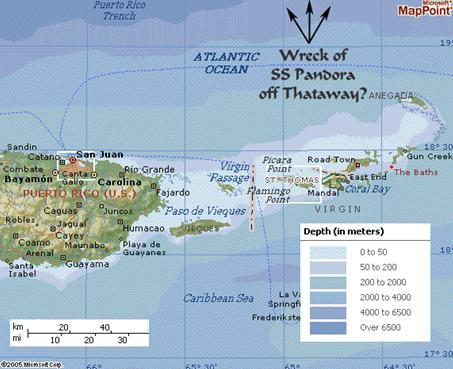
Caribbean map courtesy Microsoft MapPoint.
More locally-Bailey's Corners is about 5 miles from Shopton, and the town of Bedford is noted to be 100 miles from Shopton. Swifts maintain a "submarine plant" on a river at the head of a bay. In one place in the story, impression is given that this river is near Shopton. No mention of Lake Carlopa is made, but this river seems to have access to the Atlantic Ocean.
JP Karenko 9/6/05![]()
Tom Swift and his Air Scout | Tom Swift Among the Fire Fighters | Index